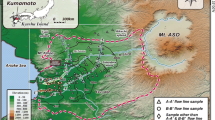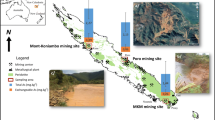Abstract
High arsenic (As) concentrations, >900 μg/L, were measured in Ca–Mg–SO4 waters from springs and drainages in the village of Pesariis in the Carnic Alps (NE Italy). Oxidation of the outcropping arsenian marcasite ore deposits of the area is proposed as the mechanism for As release into oxygenated waters during runoff. Nevertheless, the limited extension of the ore deposit and the relatively low As content of the mineralization suggest that sulfide weathering might not be the only process responsible for the highest As concentration in groundwaters. An additional mechanism involves As adsorption onto ferric iron particulate during oxidation, the drawdown in reducing environment at depth during water infiltration, and the release of ferrous iron and sorbed arsenic to the water columns by reductive dissolution of hydrous ferric oxides (HFO). This yields the observed Fe–As correlation. Newly formed HFO precipitates when groundwaters discharge to aerated conditions, leading to the removal of As, which strongly partitions into the iron-rich sediments, adsorbed onto the surface of amorphous Fe2O3·xH2O. The calculated and measured As concentration in sediments exceeds 10% by weight. Furthermore, geochemical and isotopic data indicate that the As-rich reservoir partly mixes with shallower aquifers, commonly tapped for drinking supply, representing a natural hazard for inhabitants.







Similar content being viewed by others
References
Ahmed KM, Bhattacharya P, Hasan MA, Akhter SH, Alam SMM, Bhuyian MAH, Imam MB, Kahan AA, Sracek O (2004) Arsenic enrichment in groundwater of the alluvial aquifers in Bangladesh: an overview. Appl Geochem 18:181–200
Akai J, Izumi K, Fukuhara H, Masuda H, Nakano S, Yoshimura T, Ohfuji H, Md Anawar H, Akai K (2004) Mineralogical and geomicrobiological investigations on groundwater arsenic enrichment in Bangladesh. Appl Geochem 19:215–230
Blowes DW, Ptacek CJ, Jurjovec J (2003) Mill tailings: hydrogeology and geochemistry. In: Jambor JL, Blowes DW, Ritchie AIM (eds) Environmental aspects of mine wastes, MAC Short Courses, vol 31, pp 95–116
Bonnissel-Gissinger P, Alnot M, Ehrhardt JJ, Behra P (1998) Surface oxidation of pyrite. Environ Sci Technol 32:2839–2845
Buschmann J, Berg M, Stengel C, Winkel L, Sampson ML, Pham TKT, Pham HV (2008) Contamination of drinking water resources in the Mekong delta floodplains: arsenic and other trace metals pose serious health risk to population. Environ Int 34(6):756–764
Capaccioni B, Didero M, Paletta C, Salvadori P (2001) Hydrogeochemistry of groundwaters from formations with basal gypsiferous layers: an example from Mt Catria–Mt Nerone ridge (Northern Appenines, Italy). J Hydrol 253:14–26
Carulli GB, Ponton M (1992) Interpretazione strutturale profonda del settore centrale carnico-friulano. [Structural data interpreatation form the central part of the Friulian Alps]. In: Studi Geologici Camerti, pp 275–284 [in Italian]
Chakraborti D (1995) Arsenic contamination in six districts of West Bengal, India: the background. In: Proceedings of the international conference on arsenic in groundwater: cause, effects and remedy. Kolkata, 3
Chen S, Yeh S, Yang M, Lin T (1995) Trace element concentration and arsenic speciation in the well water of a Taiwan area with endemic blackfoot disease. Biol Trace Elem Res 48:263–274
Chowdhury UK, Biswas BK, Chowdhury TR, Samanta G, Mandal BK, Basu GC, Chanda CR, Lodh D, Saha KC, Mukherjee SK, Roy S, Kabir S, Quamruzzaman Q, Chakraborti D (2000) Groundwater arsenic contamination in Bangladesh and West Bengal, India. Environ Health Perspect 108:393–397
Comin-Chiaramonti P (1973) Segnalazione di una mineralizzazione a prevalenti marcasite e pirite e di una formazione tufitica nell’Anisico del Rio Fuina (Val Pesarina, Carnia). [Preliminary results from a mineralised area dating back to Anisic found along the Fuina Brook in Val Pesarina, Carnia]. Atti Mem Acc Patavina Sci Lett Arti LXXXV: 91–99 (in Italian)
Cortecci G, Dinelli E, Mussi M (2000) Chemical and isotopic analyses of the “Acqua Pudia” groundwater from the Arta Terme (Carnia, north-eastern Italy). Miner Petrogr Acta XLIII:143–151
Duker AA, Carranza EJM, Hale M (2005) Arsenic geochemistry and health. Environ Intern 31:631–641
Dzombak DA, Morel FMM (1990) Surface complexation modeling: hydrous ferric oxide. Wiley, NY, p 393
Elmi C, Monesi A (1967) Ricerche geologiche nella Tavola di Prato Carnico. [The geology of Prato Carnico]. Annali del Museo Geologico di Bologna, Serie 2b, XXXIV:1–18 (in Italian)
Franklin JM (1993) Volcanic-associated massive sulphide deposits. In: Kirkam RV, Sinclair WD, Thorpe RI, Duke JM (eds) Mineral deposit modeling. Geolog Assoc Canada, Special Paper 40:315–334
Fuller CC, Davis JA, Waychunas GA (1993) Surface chemistry of ferrihydrite: part 2. Kinetics of arsenate adsorption and coprecipitation. Geochim Cosmochim Acta 57:2271–2282
Gomez-Arroyo S, Armienta MA, Cortes-Eslava J, Villalobos-Pietrini R (1997) Sister chromatid exchanges in Vicia faba induced by arsenic contaminated drinking water from Zimapan, Hidalgo, Mexico. Mutat Res 394:1–7
Hopenhayn C (2006) Arsenic in drinking water: impact on human health. Elements 2:103–107
Lloyd JR, Oremland RS (2006) Microbial transformations of arsenic in the environment: from soda lakes to aquifers. Elements 2:85–90
Longinelli A, Selmo E (2003) Isotopic composition of precipitation in Italy: a first overall map. J Hydrol 270:75–80
Ludwig KR (1994) Analyst. A computer program for control of a thermal-ionization single-collector mass-spectrometer. USGS. Open-file report 92–543
Merian E (1991) Metals and their compounds in the environment: occurrence, analysis and biological relevance. VCH, Weinheim
Morales KH, Ryan L, Kuo TL, Wu MM, Chen CJ (2000) Risk of internal cancers from arsenic in drinking water. Environ Health Perspect 108:655–661
Morin G, Calas G (2006) Arsenic in soils, mine tailings, and former industrial sites. Elements 2:97–101
Naumov GB, Ryzhenko BN, Khodakovsky IL (1974) Handbook of Thermodynamic data. USGS Rep 74–101
Nickson RT, McArthur JM, Ravenscroft P, Burgess WG, Ahmed KM (2000) Mechanism of arsenic release to groundwater, Bangladesh and West Bengal. Appl Geochem 15:403–415
Ning Z, Lobdell DT, Kwok RK, Liu Z, Zhang S, Chenlong MA, Riediker M, Mumford J (2007) Residential exposure to drinking water arsenic in Inner Mongolia, China. Toxicol Appl Pharmac 222:351–356
Nordstrom DK (1982) Aqueous pyrite oxidation and the consequent formation of secondary iron minerals. Soil Sci Soc Am Special Publ 10:37–46
O’Day PA, Vlassopoulos D, Root R, Rivera N (2004) The influence of sulfur and iron on dissolved arsenic concentrations in the shallow subsurface under changing redox conditions. PNAS 101:13703–13708
Oscarson DW, Huang PM, Liaw WK (1980) The oxydation of arsenic by aquatic sediments. J Environ Qual 9:700–703
Parkhurst DL and Appelo CAJ (1999) User’s Guide to Phreeqc (Version 2)—a computer program for speciation, batch-reaction, one-dimensional transport, and inverse geochemical calculations; water-resources investigations. USGS Report 99–4259, Denver
Piper AM (1944) A graphic procedure in the geochemical interpretation of water analyses. Am Geophy Un Transact 25:914–923
Plummer LN, Busby JF, Lee RW, Handshaw BB (1990) Geochemical modeling in the Madison aquifer in parts of Montana, Wyoming and South Dakota. Water Resour Res 26:1981–2014
Schwertmann U, Fischer WR (1973) Natural amorphous ferric hydroxide. Geoderma 10:237–247
Smedley PL, Kinniburgh DG (2002) A review of source, behaviour and distribution of arsenic in natural waters. Appl Geochem 17:517–568
Taylor SR, McLennan SM (1995) The geochemical evolution of the continental crust. Rev Geophys 33:241–265
Tseng WP (1977) Effects and dose-response relationships of skin cancer and blackfoot disease with arsenic. Environ Heal Perspect 19:109–119
Vahter M, Concha G, Nermell B, Nilsson R, Dulout F, Natarajan AT (1995) A unique metabolism of inorganic arsenic in native Andean women. Eur J Pharmacol 293:455–462
Venturini C (2002) Geological map of the Carnic Alps (scale 1:25000)
Waychunas GA, Rea BA, Fuller CC, Davis JA (1993) Surface chemistry of ferrihydrite: part I. EXAFS studies of the geometry of coprecipitated and adsorbed arsenate. Geochim Cosmochim Acta 57:2251–2269
WHO (2001) Environmental health criteria 224: arsenic compounds, 2nd edn. WHO, Geneva
Williams M (2001) Arsenic in mine waters: an international study. Environ Geol 40:267–278
Acknowledgments
L. Fanfani and U. Aviani are thanked for helpful discussions; critical comments and suggestions of an anonymous reviewer greatly improved the early version of the manuscript. D. Lenaz performed XRD spectra and provided one specimen of marcasite. Part of this study was financially supported by the INGV-DPC S2 project.
Author information
Authors and Affiliations
Corresponding author
Rights and permissions
About this article
Cite this article
Petrini, R., Slejko, F., Lutman, A. et al. Natural arsenic contamination in waters from the Pesariis village, NE Italy. Environ Earth Sci 62, 481–491 (2011). https://doi.org/10.1007/s12665-010-0541-3
Received:
Accepted:
Published:
Issue Date:
DOI: https://doi.org/10.1007/s12665-010-0541-3




